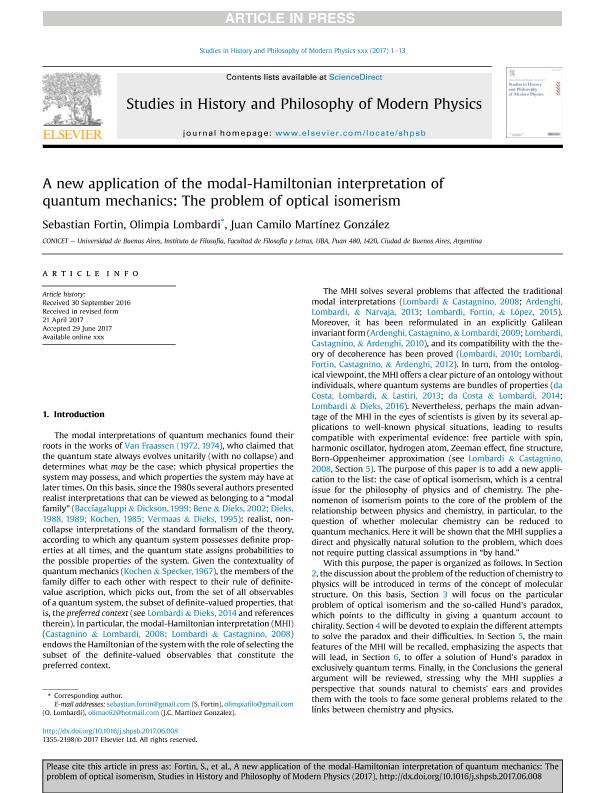Mostrar el registro sencillo del ítem
dc.contributor.author
Fortin, Sebastian Ezequiel

dc.contributor.author
Lombardi, Olimpia Iris

dc.contributor.author
Martínez González, Juan Camilo

dc.date.available
2019-03-26T17:46:48Z
dc.date.issued
2018-05
dc.identifier.citation
Fortin, Sebastian Ezequiel; Lombardi, Olimpia Iris; Martínez González, Juan Camilo; A new application of the modal-Hamiltonian interpretation of quantum mechanics: The problem of optical isomerism; Elsevier; Studies In History And Philosophy Of Modern Physics; 62; 5-2018; 123-135
dc.identifier.issn
1355-2198
dc.identifier.uri
http://hdl.handle.net/11336/72553
dc.description.abstract
In the context of the debates about the nature of molecularstructure, in this paper we have focused on Hund's paradox,derived from the difficulty in giving a quantum explanation foroptical isomerism. We have revised different attempts to solve theparadox, in particular, the widespread appeal to decoherence in recent literature; we have argued that none of these attempts iscompletely successful. On this basis, we have recalled the mainfeatures of the MHI in order to show how this interpretation offersa solution of Hund´s paradox in exclusively quantum terms.Since its first formulation in 2008, the MHI was developed inseveral articles, and was presented many times to varied audiences.It is interesting to notice the different reactions to the same proposal.Philosophers of physics usually insist on requiring thejustification for the selection of the Hamiltonian as the key todetermine the preferred context, by claiming that no basis of theHilbert space has a privileged status. By contrast, philosophers ofchemistry (and chemists) are always surprised by our insistence injustifying that selection, since in chemistry it is usual to work in thebasis of the energy. In fact, the MHI is in resonance with molecularchemistry, in the context of which molecules are almost alwaysdescribed in their stationary states, that is, in eigenstates of theHamiltonian, and a great deal of relevant knowledge is obtainedfrom studying the symmetries of the Hamiltonian. The MHI accountto optical isomerism fits in the framework of this resonance.
dc.format
application/pdf
dc.language.iso
eng
dc.publisher
Elsevier

dc.rights
info:eu-repo/semantics/openAccess
dc.rights.uri
https://creativecommons.org/licenses/by-nc-nd/2.5/ar/
dc.subject
Modal Hamiltonian Interpretation
dc.subject
Quantum Chemistry
dc.subject
Optical Isomers
dc.subject
Molecular Structure
dc.subject.classification
Otras Filosofía, Étnica y Religión

dc.subject.classification
Filosofía, Ética y Religión

dc.subject.classification
HUMANIDADES

dc.title
A new application of the modal-Hamiltonian interpretation of quantum mechanics: The problem of optical isomerism
dc.type
info:eu-repo/semantics/article
dc.type
info:ar-repo/semantics/artículo
dc.type
info:eu-repo/semantics/publishedVersion
dc.date.updated
2019-03-26T13:52:46Z
dc.journal.volume
62
dc.journal.pagination
123-135
dc.journal.pais
Países Bajos

dc.journal.ciudad
Amsterdam
dc.description.fil
Fil: Fortin, Sebastian Ezequiel. Universidad de Buenos Aires. Facultad de Filosofía y Letras. Instituto de Filosofía "Dr. Alejandro Korn"; Argentina. Consejo Nacional de Investigaciones Científicas y Técnicas; Argentina
dc.description.fil
Fil: Lombardi, Olimpia Iris. Universidad de Buenos Aires. Facultad de Filosofía y Letras. Instituto de Filosofía "Dr. Alejandro Korn"; Argentina. Consejo Nacional de Investigaciones Científicas y Técnicas; Argentina
dc.description.fil
Fil: Martínez González, Juan Camilo. Universidad de Buenos Aires. Facultad de Filosofía y Letras. Instituto de Filosofía "Dr. Alejandro Korn"; Argentina. Consejo Nacional de Investigaciones Científicas y Técnicas; Argentina
dc.journal.title
Studies In History And Philosophy Of Modern Physics

dc.relation.alternativeid
info:eu-repo/semantics/altIdentifier/url/http://www.sciencedirect.com/science/article/pii/S1355219816301605
dc.relation.alternativeid
info:eu-repo/semantics/altIdentifier/doi/http://dx.doi.org/10.1016/j.shpsb.2017.06.008
Archivos asociados
